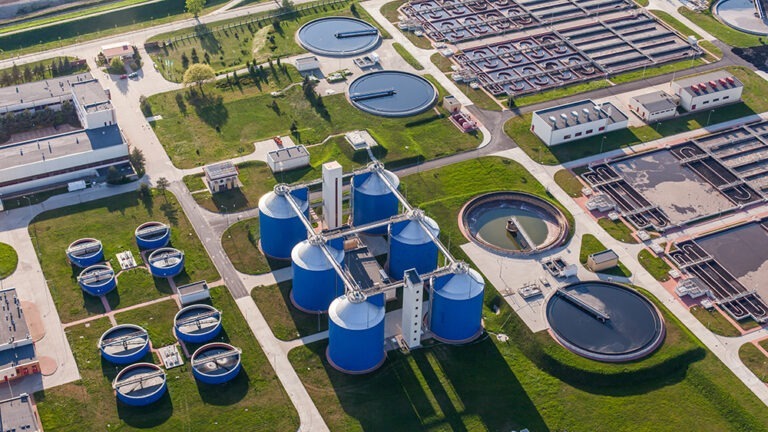A new compliance standard is on the horizon for per- and polyfluoroalkyl substances (PFAS). By the end of 2023, the U.S. Environmental Protection Agency (EPA) intends to finalize its draft guidance establishing maximum contaminant levels (MCLs) for six of the most common PFAS.
These MCLs will set the EPA’s compliance standards for water found to be contaminated with PFAS, laying the groundwork for enforcement actions. And since PFAS tend to show up everywhere they are tested for — even in rainwater — businesses across all industry sectors should understand and prepare for the potential implications of these upcoming guidelines.
Impacts of the new MCLs will reach across industries and operations
When it takes effect, the new MCL guidance will mandate that public water distribution systems start sampling for six of the most common PFAS. If sampling reveals concentrations that exceed the new MCLs, they will need to notify the public and bring their water supplies into compliance. Consequently, they will likely seek to trace the sources of PFAS contamination — meaning that any operation potentially emitting PFAS that migrate into water supplies can find itself potentially responsible for investigation and remediation.
In addition, many states and the EPA apply MCLs as groundwater protection standards under the Resource Conservation and Recovery Act (RCRA); the Comprehensive Environmental Response, Compensation, and Liability Act (CERCLA or Superfund); and brownfield programs. This means that even if the groundwater at a site undergoing remedial investigation is not used as a public water supply, regulators may evaluate PFAS in groundwater relative to the MCLs — and then expect response actions if the MCLs are exceeded.
Potential PFAS source areas identified by the EPA include sites where firefighting foams containing PFAS have been stored or used (such as refineries and airports listed under Part 139 by the Federal Aviation Administration), industrial and manufacturing sites that use or produce products containing PFAS, landfills, and others. Sites undergoing corrective action under RCRA or remedial investigation and five-year reviews under Superfund may have additional PFAS-specific sampling and compliance requirements. Real estate developers with brownfield sites will also need to take note, as state-driven brownfield regulations will likely include PFAS.
Key takeaways from the EPA’s proposed guidance
Six common PFAS will get new MCLs. The EPA’s guidelines will establish MCLs for Perfluorooctanoic acid (PFOA), Perfluorooctane Sulfonate or Perfluorooctane Sulfonic Acid (PFOS), Perfluorohexane sulfonate (PFHxS), Hexafluoropropylene oxide dimer acid (HFPO-DA) and its ammonium salt (also known as GenX), Perfluorononanoic acid (PFNA), and Perfluorobutane sulfonic acid (PFBS). For two of the compounds — PFOA and PFOS — the EPA is proposing MCLs of 4 parts per trillion (ppt), which is equivalent to 0.004 micrograms per liter. For the other four compounds — PFHxS, HFPO-DA and GenX, PFNA, and PFBS — the EPA is proposing an MCL that does not exceed a hazard index of 1, based on the concentrations of these compounds as a mixture in drinking water.
The EPA’s proposed MCLs are lower than any current state limits for drinking water.
The EPA arrived at its proposed MCLs for PFOA and PFOS by assessing both and concluding they are likely carcinogenic to humans. Existing EPA guidelines establish a maximum contaminant level goal for carcinogens at 0 ppt and strive to set the MCL as close to that number as possible. Through testing and a cost-benefit evaluation, the agency determined that 4 ppt was the lowest technically feasible limit.
This number is lower than current states’ MCLs, many of which are set at or near 10 ppt. Once the EPA establishes final MCLs, states will be required to adopt the values set by the EPA.
In addition, the approach proposed for PFHxS, HFPO-DA and GenX, PFNA, and PFBS implies that the sum of the concentration of these compounds cannot exceed 10 ppt, lower than any currently existing state limits for them.

How to plan for the new MCLs
These new MCLs will drive EPA and state remediation expectations and lay the groundwork for more enforcement actions. So how can you prepare?
- Understand your physical relationship to public water sources. If your organization uses or has potentially released PFAS, gauge where your sites and operations are in relation to public water supplies (both with respect to groundwater and surface water). If testing at any of these systems reveals levels of these compounds that exceed the new limits, we recommend that you understand your potential responsibility or liability related to any resulting investigations and/or enforcement actions.
- Understand your region’s risk level. Multiple studies have demonstrated that these PFAS may exist at concentrations close to the new MCLs as a regional background level simply as the result of general human activity. For example, septage may contain high amounts of PFAS due to the use of commercial products bearing PFAS, so rural areas where septic tanks are common may have higher background levels of these compounds. Organizations may want to develop a strong understanding of their regions’ PFAS baselines so they can accurately assess the impacts, or lack thereof, from their own operations.
- Understand the environmental justice (EJ) connection. PFAS contamination will tie into existing EJ concerns. With the EPA’s requirement that water suppliers notify the public of any MCL exceedances, organizations should prepare to answer related concerns from their surrounding communities — whether or not those organizations are responsible for the contamination. Urban areas may have elevated concentrations of PFAS, which overlap with EJ communities as defined by state and local tools that assess risk factors, so organizations already managing EJ concerns in those areas may want to pay particular attention.
- Understand the bigger regulatory picture and how it might impact your organization’s plans. These new MCLs represent only part of the EPA’s PFAS Strategic Roadmap; along a similar timeline, the agency is likely to include some PFAS as substances regulated under Superfund and RCRA. Collectively, this suggests that sites regulated under CERCLA or RCRA will likely encounter an obligation to test for PFAS. Organizations should evaluate their current projects and plans for the possibility of PFAS-related risks in light of these developments.
Our consultants understand the complexities of this regulatory landscape, how to work with relevant agencies and public entities, and the challenges related to tracking the source of PFAS. Please contact us for more information about the technical, regulatory, and operational aspects of PFAS management.
Published: 6/22/2023
- Aerospace
- Education, healthcare, and cultural institutions
- Energy
- Environmental trusts
- Government infrastructure
- Industrial and manufacturing
- Mining
- Real estate developers
- Contaminated site management
- Emerging contaminants
- Environmental risk assessment
- PFAS
- Site characterization
- Remediation
- Sustainability
Authors

Principal Consultant, Risk Assessment

Senior Technical Specialist




